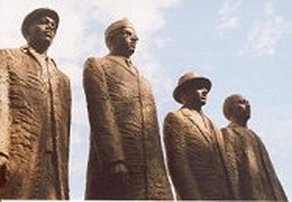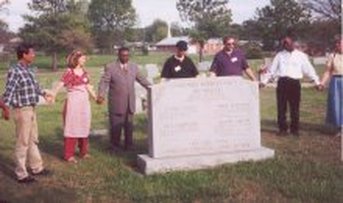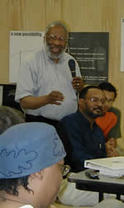2001 GREENSBORO
In April 2002, faith-based activists from around the United States and five other countries gathered in Greensboro, NC for study and analysis, prayer and worship, celebration and community-building for the inaugural, week-long Word & World School. The history of struggle for justice and social transformation in Greensboro and the people who offered their stories of shared and personal involvement, commitment and faith inspired us to reach deeper into our own lives to embody faithful witness.
Components:
• Greensboro Courses, Faculty and Roundtables
• Greensboro Site Visits and Plenary Sessions
• Small Group Practicums and Covenanting Ritual
• Worship and Prayer
• Music, Poetry and Celebration
• Greensboro Circle of Support
• Participant Comments
Components:
• Greensboro Courses, Faculty and Roundtables
• Greensboro Site Visits and Plenary Sessions
• Small Group Practicums and Covenanting Ritual
• Worship and Prayer
• Music, Poetry and Celebration
• Greensboro Circle of Support
• Participant Comments
GREENSBORO COURSES, FACULTY AND ROUNDTABLES
Participants in the Greensboro Word & World School chose two intensive courses, one from the Church Practices track and the other from the Social/Cultural Practices track. Each course consisted of four 90-minute sessions. Class size was kept small (no more than 15 people per class).
Following is a list of the Greensboro Word and World faculty and classes offered:
Church Practices
Following is a list of the Greensboro Word and World faculty and classes offered:
Church Practices
The Beloved Community: Nelson Johnson & Bill Wylie-Kellerman
Church as Movement 101: Core Biblical Narratives Ched Myers & Kazi Joshua
Building Communities of Hope and Struggle: Jim Dickerson
Spirituality and Struggle: Selena Blackwell
There is a River: Streams of Radical Biblical Tradition: Rose Marie Berger, Mari Castellanos, Uncas McThenia & Will O’Brien
Truth and Reconciliation: The Power of Forgiveness : Gregory Headon, Joyce Hollyday & Joyces Johnson
Social/Cultural Practices
The Arts & Social Change: Jim Perkinson & Ange Smith
Intro to Social Analysis: Kazi Joshua
Movement History: Vincent Harding
Responding to Global Violence : Z. Holler & Ed Whitfield
Multiple Layers of Oppression: Melanie Morrison
Restorative Justice: Elaine Enns & Iris de León Hartshorn
Roundtables
Roundtable discussions were moderated Tuesday and Thursday evenings by Dr. Vincent Harding.
Religion and the Future of Democracy in America
Working for Social Change and the Reign of God in a post-September 11 World
GREENSBORO SITE VISITS AND PLENARY SESSIONS
One of the tenets of Word and World is the belief that rich theological and sociological reflection arises when the Word of God and the realities of the world come into dialogue in the local context. Our week together began with worship at Faith Community Church and Sunday dinner prepared by Bethel AME Church, followed by visits to four key Movement history sites in Greensboro. Morning plenary sessions addressed Greensboro Movement history and functioned in many ways as the key text of engagement and reflection for each day, having a cumulative effect as we came towards the end of the week. Here is a brief summary of these plenaries.
The Sit-In Movement of the 1960s
We were blessed to have people with us who were part of the first days of the sit-in movement in Greensboro in the 1960s. Lewis Brandon, Pat Patterson and Clarence Henderson helped us understand the struggle within families regarding what a sit-in would mean. After much talk and analysis, the time had come to take a stand. In the words of Pat Patterson, “God was whispering in my ear.” It was not the first time students from Greensboro had tried to desegregate facilities. In 1935, students from Bennett, a women’s college in Greensboro, had also attempted to desegregate public spaces in the city. The 1960 sit-in action was thus rooted in a history of student activism that we are only beginning to appreciate. Courage, study, faith and community mobilization came together in Greensboro. The sit-in movement then spread across the country and became the backbone of the Civil Rights Movement. All because a group of young people stopped talking and decided in faith to act.
Dudley – A & T Revolt, 1969
Claude Barnes, a student at Dudley high school, ran for student council president and won, but was prevented from taking his seat because of his radical politics. The situation escalated when Barnes, now chair of the political science department at A & T University, decided to march on the school with a few friends. The response from the power structure was disproportionate to the demonstration. Riot police were called out, and the National Guard became part of the escalation. Dr. Barnes and Ed Whitfield detailed in this plenary what they called “the missing pages in the Civil Rights Movement,” providing an analysis of the movement. They charted the changing course of ideas in the movement, including black power and Pan-Africanism. In retrospect they feel that a less ideologically motivated movement would have been healthier.
1979 Klan Massacre
Ed Whitfield, Willena Canon, and Nelson Johnson narrated their involvement in the labor movement and the events that led to the massacre of labor organizers in 1979. This was a pivotal plenary. All of the Greensboro Word and World School participants had visited the gravesites of these labor organizers, as well as Morningside Homes, where the shooting had taken place. It was clear that the police had been involved in making sure that when the labor rally started, there would be no police protection. Even today, there is still a struggle in Greensboro to try and make history right. It was a painful plenary because we saw that it was easy to portray people as less than human beings by simply calling them “communists.” In spite of several trials to get to the bottom of the killing of the five organizers, nobody has been convicted. There is a “Truth and Reconciliation” project currently underway in Greensboro to attempt to address this legacy in the interest of healing the city. We were challenged in this plenary to remember that sometimes in this struggle for justice and our attempt to change the world, lives may be lost and our commitment to nonviolence tested.
K-Mart Labor Struggle, 1995
Calvin Miller, Greg Headon, Governor Spencer, and Deborah Compton-Holt explained how K-Mart Warehouse Center employment practices and conditions had become unbearable, causing workers to organize around questions of economic justice. Attempts at organizing had been quelled. These veteran labor organizers recounted how they mobilized their families, communities, and the Pulpit Forum of Greensboro, a coalition of progressive clergy, to commit acts of civil disobedience and bring pressure to bear on K-Mart until they negotiated in good faith for a fairer contract. In the end, the workers triumphed, although the struggle continues. Students from local colleges, both black and white, joined the K-Mart boycotts and there was massive media coverage throughout the nation.
The Sit-In Movement of the 1960s
We were blessed to have people with us who were part of the first days of the sit-in movement in Greensboro in the 1960s. Lewis Brandon, Pat Patterson and Clarence Henderson helped us understand the struggle within families regarding what a sit-in would mean. After much talk and analysis, the time had come to take a stand. In the words of Pat Patterson, “God was whispering in my ear.” It was not the first time students from Greensboro had tried to desegregate facilities. In 1935, students from Bennett, a women’s college in Greensboro, had also attempted to desegregate public spaces in the city. The 1960 sit-in action was thus rooted in a history of student activism that we are only beginning to appreciate. Courage, study, faith and community mobilization came together in Greensboro. The sit-in movement then spread across the country and became the backbone of the Civil Rights Movement. All because a group of young people stopped talking and decided in faith to act.
Dudley – A & T Revolt, 1969
Claude Barnes, a student at Dudley high school, ran for student council president and won, but was prevented from taking his seat because of his radical politics. The situation escalated when Barnes, now chair of the political science department at A & T University, decided to march on the school with a few friends. The response from the power structure was disproportionate to the demonstration. Riot police were called out, and the National Guard became part of the escalation. Dr. Barnes and Ed Whitfield detailed in this plenary what they called “the missing pages in the Civil Rights Movement,” providing an analysis of the movement. They charted the changing course of ideas in the movement, including black power and Pan-Africanism. In retrospect they feel that a less ideologically motivated movement would have been healthier.
1979 Klan Massacre
Ed Whitfield, Willena Canon, and Nelson Johnson narrated their involvement in the labor movement and the events that led to the massacre of labor organizers in 1979. This was a pivotal plenary. All of the Greensboro Word and World School participants had visited the gravesites of these labor organizers, as well as Morningside Homes, where the shooting had taken place. It was clear that the police had been involved in making sure that when the labor rally started, there would be no police protection. Even today, there is still a struggle in Greensboro to try and make history right. It was a painful plenary because we saw that it was easy to portray people as less than human beings by simply calling them “communists.” In spite of several trials to get to the bottom of the killing of the five organizers, nobody has been convicted. There is a “Truth and Reconciliation” project currently underway in Greensboro to attempt to address this legacy in the interest of healing the city. We were challenged in this plenary to remember that sometimes in this struggle for justice and our attempt to change the world, lives may be lost and our commitment to nonviolence tested.
K-Mart Labor Struggle, 1995
Calvin Miller, Greg Headon, Governor Spencer, and Deborah Compton-Holt explained how K-Mart Warehouse Center employment practices and conditions had become unbearable, causing workers to organize around questions of economic justice. Attempts at organizing had been quelled. These veteran labor organizers recounted how they mobilized their families, communities, and the Pulpit Forum of Greensboro, a coalition of progressive clergy, to commit acts of civil disobedience and bring pressure to bear on K-Mart until they negotiated in good faith for a fairer contract. In the end, the workers triumphed, although the struggle continues. Students from local colleges, both black and white, joined the K-Mart boycotts and there was massive media coverage throughout the nation.
SMALL GROUP PRACTICUMS AND COVENANTING RITUAL
The vision for Word and World is that all courses operate in a spirit of “popular education,” with an emphasis on dialogue and group sharing. Each participant was assigned to a small group (5 to 8 people, maximum) that met after plenary sessions. Small groups also took turns preparing the table for community meals and cleaning up afterwards.
During the opening session of the Greensboro Word & World School we shared in a Covenanting Ritual with our small group members by dipping our hands in salt and signing our names to the covenant. Salt was a sign of hospitality in ancient time. It still is today in the east. The Hebrew Scriptures reveal that when strangers would come together to share a meal, in parting they would use an expression that is literally translated, “there is salt between us.” A loose translation would be, “we have broken bread together and we are no longer strangers, but friends.”
During the opening session of the Greensboro Word & World School we shared in a Covenanting Ritual with our small group members by dipping our hands in salt and signing our names to the covenant. Salt was a sign of hospitality in ancient time. It still is today in the east. The Hebrew Scriptures reveal that when strangers would come together to share a meal, in parting they would use an expression that is literally translated, “there is salt between us.” A loose translation would be, “we have broken bread together and we are no longer strangers, but friends.”
WORSHIP AND PRAYER
Worship, song, communion and daily prayer were powerful and joyful times together. Many thanks to our brothers and sisters in Christ who led us in worship and prayer:
Faith Community Church (Sunday Worship): Rev. Nelson Johnson, Pastor
Bethel AME Church (Sunday Meal) : Rev. Conrad Pridgen, Pastor
Genesis Baptist Church (Wednesday Evening Dinner, Interfaith Worship Service, and Candlelight Walk for Peace) : Rev. Gregory Headon, Pastor
Word and World Community (Friday Evening Communion Service, Circle of Elders, and daily Morning Prayer)
MUSIC, POETRY AND CELEBRATION
Each evening was filled with guitars, singing, spoken word, and continued conversation as we gathered around a bonfire. It was a gift to be together in faith, share our struggles and have the chance to enjoy each other’s company. Ange Smith has since recorded a powerful CD that includes songs she wrote during the Greensboro Word & World School.
GREENSBORO CIRCLE OF SUPPORT
Word and World National Steering Committee
Greensboro Coordination and Technical Assistance
Lewis Brandon, Stephanie Crisp, Connie Drew, Joyce Johnson, Nelson Johnson, Diane McFarland, Alma Purvis, Billy Sudderth and Ed Whitfield
Greensboro Advance Team
Deborah Lee, Uncas McThenia and Liz Walz
Special thanks to Greensboro School Collaborative, Beloved Community Center, Greensboro, Faith Community Church, Greensboro, Pulpit Forum of Greensboro and Vicinity and Servant Leadership School of Greensboro.
PARTICIPANT COMMENTS
“The first day I arrived at Word and World, I was really, really scared. I thought I could handle diversity and I found out I couldn’t. I had to work through this issue, and I did." “For the past several years, I’ve been wrestling with how committed I am to the movement and what I’m willing to risk for the movement. Trying to struggle analytically with that hasn’t worked. This week, I’ve learned that it’s taking many small steps that make a movement. The path is known more by walking it than thinking about it.” |
“I’ve made the commitment to be like these people and have the courage they have. It’s really inspiring.” “What also really surprised me here is that I learned that Christians can have fun. I was raised in institutional Christianity — everyone in suits and restrictions. I lost my faith because of so many rigid standards. Here I realized what Christian fellowship and fun is. I really came out of myself — it has meant a lot." |
“The people and contacts I’ve met here are going to be really positive in my future endeavors. The diversity is amazing – the issues, the knowledge, the past experiences that people bring are incredible." “Being at Word and World as an Arab-American, with all the issues going on right now, I was embraced in a way that I didn’t expect. I was allowed to express myself and have a voice. It’s been empowering for me. I’ve felt community here in ways that are really important." |



